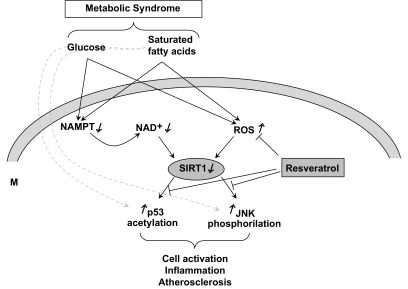FIG. 5.
Proposed mechanism whereby glucose and palmitate downregulate SIRT1 and induce activation and inflammation in monocytes. According to the data presented, high glucose and palmitate impair expression and function of NAMPT, thus reducing cell NAD+ content. As SIRT1 is NAD+ dependent, this leads to reduction of expression and activity of SIRT1. In parallel, both high glucose and palmitate promote production of ROSs, which may themselves reduce SIRT1. SIRT1 downregulation is then responsible for high p53 acetylation and JNK activation, which are related to cell activation and inflammation. All of these pathways can be prevented by the antioxidant resveratrol. We cannot rule out alternative pathways by which glucose and palmitate activate JNK and p53 independently of SIRT1 (dashed lines).

